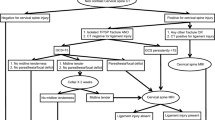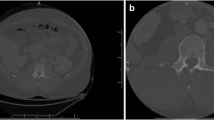Abstract
This study was performed to evaluate helical computed tomography (HCT) as the primary method of initial cervical spine assessment in multiple trauma victims. Prospective evaluation of the cervical spine using HCT and plain film radiography (PFR) was performed in 800 patients with suspected multisystem injuries. With HCT, an average of 32 slices were obtained at 5-mm intervals from the base of the skull to T1 using helical acquisition and a bone algorithm. HCT was performed following cross-table lateral radiographs of the cervical spine in all patients. We compared HCT and PFR for detection of abnormalities and duration of examination and also compared HCT with conventional CT in a subset of patients (N=20) for image quality/lesion detectability.
Sixty-eight fractures were identified in 46 patients. HCT prospectively identified 67 fractures (98.5%), and plain films demonstrated 29 fractures (43%). No difference in image quality/lesion detectability was encountered when comparing HCT to conventional CT. HCT of the cervical spine could be completed in 4.5 minutes and added an average of only 8 minutes to the stay of the patient in the CT room. During the time of the study, the overall patient disposition time from the trauma resuscitation area was reduced from 6.5 to 4.5 hours. Rapid and accurate evaluation of the cervical spine is possible with HCT and is recommended as part of the initial imaging protocol in multiple trauma patients.
Similar content being viewed by others
References
Vandemark RM. Radiology of the cervical spine in trauma patients: practice pitfalls and recommendations for improving efficiency and communication. AJR Am J Roentgenol 1990;155:465–72.
Davis JW, Phreaner DL, Hoyt DB, Mackersie RC. The etiology of missed cervical spine injuries. J Trauma 1993;34:342–6.
Mirvis SE, Diaconis JN, Chirico PA, Reiner BI, Joslyn JN, Militello P. Protocol-driven radiologic evaluation of suspected cervical spine injury: efficacy study. Radiology 1989;170:831–4.
Woodring JH, Lee C. Limitations of cervical radiography in the evaluation of acute cervical trauma. J Trauma 1993;34:32–9.
Ahmad AA, Coin CG, Becerra JL, Nuñez DB Jr, Soto RF, LeBlang SD. Plain films versus spiral CT in the evaluation of cervical spinal injuries [abstr]. Radiology 1993;189:325.
Acheson MB, Livingston RR, Richardson ML, Stimac GK. High-resolution CT scanning in the evaluation of cervical spine fractures: comparison with plain film examinations. AJR Am J Roentgenol 1987;148:1179–85.
Woodring JH, Lee C. The role and limitations of computed tomographic scanning in the evaluation of cervical trauma. J Trauma 1992;33:698–708.
Fishman EK, Ney DR. Advanced computer applications in radiology: clinical applications. Radiographics 1993;13:463–75.
Heiken JP, Brink JA, Vannier MW. Spiral (helical) CT. Radiology 1993;189:647–56.
Author information
Authors and Affiliations
Rights and permissions
About this article
Cite this article
Nuñez, D.B., Ahmad, A.A., Coin, C.G. et al. Clearing the cervical spine in multiple trauma victims: A time-effective protocol using helical computed tomography. Emergency Radiology 1, 273–278 (1994). https://doi.org/10.1007/BF02614949
Issue Date:
DOI: https://doi.org/10.1007/BF02614949




